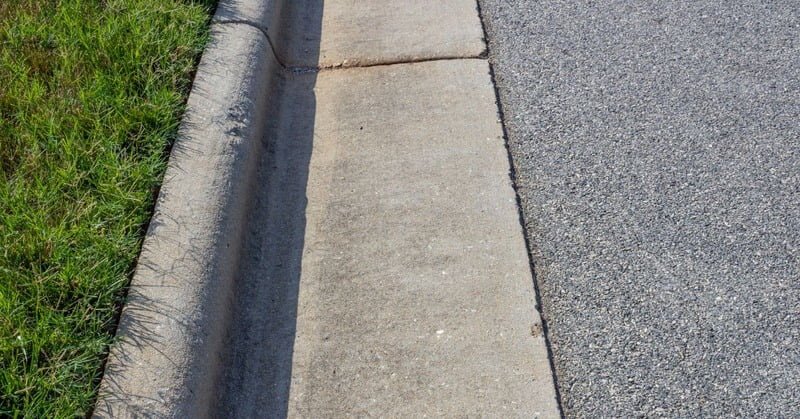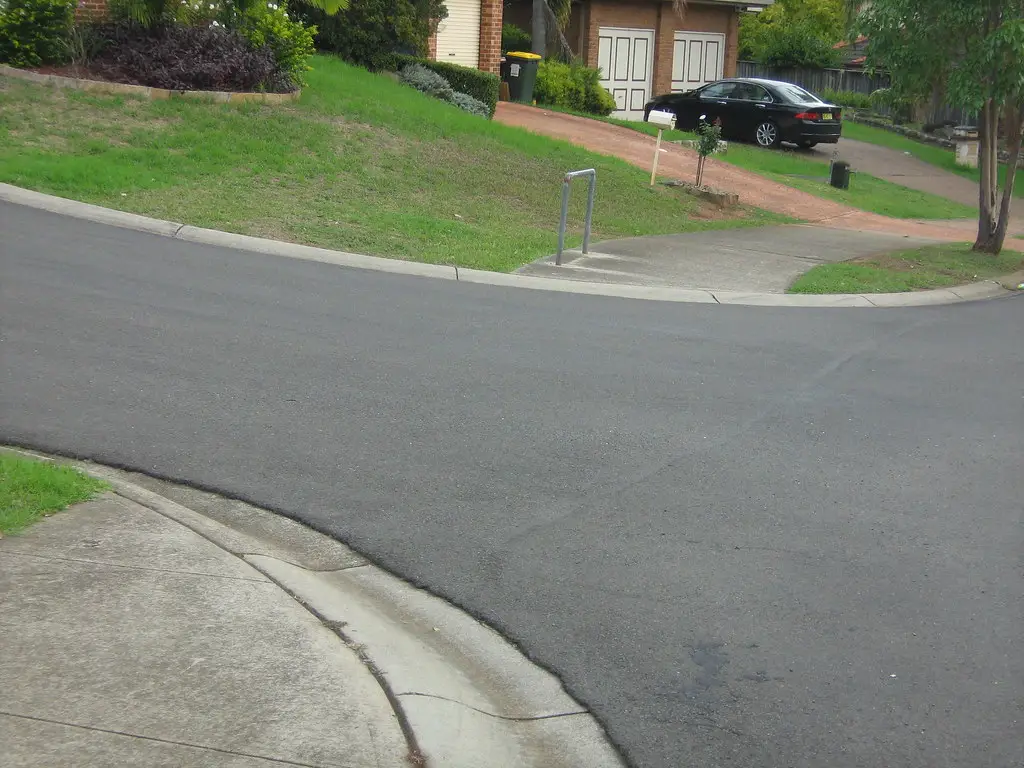Blog
The 9 Different Types of Curbs: A Quick Guide for Car Owners
When it comes to driveways, one element that’s often overlooked but undeniably crucial is the curb.
At their core, curbs are essentially barriers—whether they are preventing your car from driving onto the sidewalk or directing rainwater away from properties. They delineate the boundary between the road and everything else, acting as guardians of our pathways.
There are various types, and knowing each one is crucial if you drive on a daily basis.
Let’s try and explore each one of them:
Table of Contents
What are the Different Types of Curbs?
1. Barrier or Straight Curbs

Barrier curbs, sometimes referred to as straight curbs, are prevalent worldwide.
As the name implies, these curbs act as barriers, ensuring vehicles remain on the pavement and out of restricted spaces like lawns, parks, and sidewalks. They can be made of either asphalt aggregates or cement concrete.
Some variants even come with recessed parts or curb cuts, especially at the end of driveways, to facilitate easier vehicle or pedestrian access.
Pros
- Effective in keeping vehicles on the road.
- Made from versatile materials like asphalt or concrete.
- Features curb cuts for easier access.
Cons
- Restrictive in certain urban designs.
- It can be a trip hazard for pedestrians.
2. Monolithic or Integral Curbs
Monolithic curbs are sleek and are fused with the road, providing a seamless look.
They’re not just about aesthetics; their design enhances the road’s durability, ensures a smooth transition, and minimizes damage even when larger vehicles pass.
Another advantage is their longevity; with no water penetration at the joints, these curbs often outlast their counterparts.
Pros
- Provides a seamless road appearance.
- Designed for durability and long lifespan.
- Resistant to water penetration at joints.
Cons
- Complex installation process.
- Potentially higher installation costs.
3. Mower Curbs
Found in yards or parks, mower curbs are both decorative and functional.
With a unique design that features a flat side bordering the lawn and a raised side adjacent to flower beds or gardens, they enable lawnmowers to cut grass efficiently without causing damage to the curb or nearby flowerbeds.
Pros
- Combines aesthetics with functionality.
- Allows efficient mowing near edges.
Cons
- Primarily suitable for gardens and parks.
- Susceptible to wear from mowers.
4. Slanted or Sloped Curbs
Purely cosmetic, slanted curbs add a touch of elegance to a property.
They are thin strips of concrete that lean towards one side, often the yard. While they do separate two areas, like a road and a yard, they’re primarily a design choice rather than a functional necessity.
Pros
- Adds elegance to properties.
- Clearly separates areas like roads and yards.
Cons
- Primarily for aesthetic appeal.
- Might be mistaken for mountable curbs.
5. Mountable or Rolling Curbs

Often confused with barrier curbs, mountable curbs boast a slanted design.
Roll curbs are designed to be gentler on vehicles. Their unique architecture allows vehicles to drive over them easily. These curbs serve a dual purpose: acting as a barrier and providing a more accessible entry and exit point for driveways.
Unlike the traditional sharp-edged concrete curbs, these are rounded, allowing cars to drive over them with less risk of damage. They are often found in residential areas and are ideal for access driveways.
However, their continuous design, without curb cuts, may pose a challenge or even cause damage to certain vehicles.
Pros
- Designed for easy vehicle access.
- Acts as a barrier and driveway access.
Cons
- It can damage certain vehicles.
- Often confused with other curb types.
6. Concrete Curbs
Concrete curbs are the most common type found in urban areas. They are made from concrete curb formwork, often reinforced with deformed steel bars for added strength.
These curbs provide a clear demarcation between the pavement slab and the roadside.
Pros
- Durability and long lifespan
- Low maintenance requirements
Cons
- Initial installation cost
- Potential for cracking over time
7. Curb and Gutter
A combination of a curb and gutter, this type is essential for proper water drainage. The curb acts as a barrier, while the gutter facilitates the flow of rainwater away from the road, protecting the internal structure of the pavement.
Pros
- Effective water drainage.
- Protects pavement from water damage.
Cons
- Higher installation costs.
- Potential maintenance needs.
8. Separate Curb
As the name suggests, a separate curb is not integrated with the sidewalk. It stands alone, usually a few inches away from the sidewalk, offering pedestrians an extra layer of protection.
Pros
- Extra pedestrian protection.
- Simpler, potentially cost-effective design.
Cons
- Less efficient drainage.
- May not define clear boundaries between roads and sidewalks.
9. Protective Barrier Curbs
These are heavy-duty curbs found in areas like parking lots and near high-traffic roads. They are designed to act as a protective barrier, preventing vehicles from accidentally entering pedestrian zones or damaging property.
Pros
- Heavy-duty protection.
- Prevents accidental vehicle entry.
Cons
- Higher installation costs.
- Limited aesthetic appeal.
How Do These Curb Types Affect You as a Car Owner?

Every curb type comes with its own set of challenges.
Whether it’s the jolt from a barrier curb or the potential water damage from a poorly designed integral curb, the implications can be numerous.
But the real nemesis for many car owners is the rolled curb.
While seemingly harmless, these curbs are notorious for their subtle, relentless wear on a car’s undercarriage and the shock they can give to the suspension over time.
But this doesn’t mean that you and your car have to suffer every single time you encounter one.
Enter Smooth Curb – Driveway Curb Ramp.
How Does Smooth Curb Help You Navigate These Different Types of Curbs?

Our solution is designed to alleviate the daily wear and tear your vehicle experiences from curbs, especially those pesky rolled ones.
Think of us as the buffer, the middleman ensuring your car gets the smooth ride it deserves every single time.
With Smooth Curb by your side, confidently navigate any driveway or parking scenario, knowing your vehicle’s undercarriage is shielded from unexpected scrapes and bumps.
We’re not just about helping you avoid those unfortunate vehicle-curb encounters; we’re about granting you peace of mind.
So, the next time you cringe at approaching that familiar rolled curb, remember there’s a simple, effective solution within reach. Smooth Curb. Because every car deserves a smooth transition.
Frequently Asked Questions
Let’s address some questions that might not have been thoroughly covered in the discussion above.
Why is it essential to know the different types of curbs?
As a car owner, understanding the different types of curbs helps you anticipate potential challenges, especially when parking or entering driveways.
I’ve heard about rolled curbs being a particular issue. What makes them different?
Rolled curbs have a rounded or sloped transition from the street to the driveway. While they may seem less abrasive, driving over them regularly can still harm your car’s undercarriage and suspension.
Are certain types of curbs more damaging to cars than others?
While each curb type has its unique challenges, rolled curbs tend to be the most notorious for car owners. Their design can lead to gradual wear on a car’s undercarriage and affect the suspension.
However, with Smooth Curb, you can mitigate these challenges, ensuring a smoother experience.


